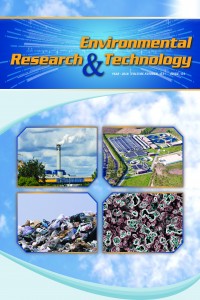Abstract
Pesticides are an integral part of modern agriculture
in most countries as a tool for controlling pests. In the last few decades,
increasing use of pesticides is polluting environment and water resources day
by day. Adsorption is one of the most used method for removal of these
pollutions due to the simple ease of processing, low cost and effective even in
very low concentrations. Active carbon is very efficient adsorbent for removing
pesticides from aqueous solutions thanks to its high surface area and porosity.
However, the high cost of active carbon can be sometimes restricted for several
purposes.
In recent years, research on the production of low
cost adsorbents alternative to commercially available activated carbon has
increased. Therefore, in this work, peanut shells were used as an adsorbent for
removing 2,4-dichlorophenoxyacetic
acid (2,4-D) from aqueous solutions. The adsorption
performance was studied depending on initial concentrations of 2,4-D solutions.
Keywords
References
- [1]. Z. Al-Qodah, A.T. Shawaqfeh, and W.K. Lafi, “Adsorption of pesticides from aqueous solutions using oil shale ash,” Desalination, vol. 208, pp. 294–305, 2007.
- [2]. V.K. Gupta, I. Ali, Suhas, and V.K. Saini, “Adsorption of 2,4-D and carbofuran esticides using fertilizer and steel industry wastes,” Journal of Colloidal and Interface Science, vol. 299, pp. 556–563, 2006.
- [3]. M. Khoshnood, and S. Azizian, “Adsorption of 2,4-dichlorophenoxyacetic acid pesticide by graphitic carbon nanostructures prepared from biomasses,” Journal of Industrial and Engineering Chemistry, vol. 18, pp. 1796–1800, 2012.
- [4]. J. Gao, G. Zhao, M. Liu, D. Li, “Mechanism of Enhanced Electrochemical Oxidation of 2,4-dichlorophenoxyacetic Acid with in situ Microwave Activated Boron-doped Diamond and Platinum Anodes,” Journal of Physical Chemistry A, vol. 113, pp. 10466-10473, 2009.
- [5]. M. Alvarez., T. Lo ́ pez, J.A. Odriozola, M.A. Centeno, M.I. Domı ́nguez, M. Quintana, D.H. Aguilar, R.D. Gonza ́lez, “2,4-Dichlorophenoxyacetic acid (2,4-D) photodegradation using an Mn+/ZrO2 photocatalyst: XPS, UV– vis, XRD characterization,” Applied Catalysis B, vol. 73, pp. 34-41, 2007.
- [6]. J.L. Acero, F. Javier Benitez, F.J. Real, C. Maya, “Oxidation of Acetamide Herbicides in Natural Waters by Ozone and by the Combination of Ozone/Hydrogen Peroxide: Kinetic Study and Process Modeling,” Industrial and Engineering Chemistry Research, vol. 42, pp. 5762-5769, 2003.
- [7]. H. El Bakouri, J. Usero, J. Morillo, R. Rojas, A. Ouassini, “Drin pesticides removal from aqueous solutions using acid-treated date stones,” Bioresource Technology, vol. 100, pp. 2676-2684 2009.
- [8]. H. El Bakouri, J. Usero, J. Morillo, A. Ouassini, “Adsorptive features of acid-treated olive stones for drin pesticides: Equilibrium, kinetic and thermodynamic modeling studies,” Bioresource Technology, vol. 100, pp. 4147-4155, 2009.
- [9]. W.T. Tsai., K.J. Hsien, Y.M. Chang, C.C. Lo, “Removal of herbicide paraquat from an aqueous solution by adsorption onto spent and treated diatomaceous earth,” Bioresource Technology, vol. 96, pp. 657-663, 2005.
- [10]. N. Ayar., B. Bilgin, G. Atun, “Kinetics and equilibrium studies of the herbicide 2,4-dichlorophenoxyacetic acid adsorption on bituminous shale,” Chemical Engineering Journal, vol. 138, pp. 239-248, 2008.
- [11]. Y. Xi, M. Mallavarapu, R. Naidu, “Adsorption of the herbicide 2,4-D on organo-palygorskite,” Applied Clay Science, vol. 49, pp. 255-261, 2010.
Abstract
References
- [1]. Z. Al-Qodah, A.T. Shawaqfeh, and W.K. Lafi, “Adsorption of pesticides from aqueous solutions using oil shale ash,” Desalination, vol. 208, pp. 294–305, 2007.
- [2]. V.K. Gupta, I. Ali, Suhas, and V.K. Saini, “Adsorption of 2,4-D and carbofuran esticides using fertilizer and steel industry wastes,” Journal of Colloidal and Interface Science, vol. 299, pp. 556–563, 2006.
- [3]. M. Khoshnood, and S. Azizian, “Adsorption of 2,4-dichlorophenoxyacetic acid pesticide by graphitic carbon nanostructures prepared from biomasses,” Journal of Industrial and Engineering Chemistry, vol. 18, pp. 1796–1800, 2012.
- [4]. J. Gao, G. Zhao, M. Liu, D. Li, “Mechanism of Enhanced Electrochemical Oxidation of 2,4-dichlorophenoxyacetic Acid with in situ Microwave Activated Boron-doped Diamond and Platinum Anodes,” Journal of Physical Chemistry A, vol. 113, pp. 10466-10473, 2009.
- [5]. M. Alvarez., T. Lo ́ pez, J.A. Odriozola, M.A. Centeno, M.I. Domı ́nguez, M. Quintana, D.H. Aguilar, R.D. Gonza ́lez, “2,4-Dichlorophenoxyacetic acid (2,4-D) photodegradation using an Mn+/ZrO2 photocatalyst: XPS, UV– vis, XRD characterization,” Applied Catalysis B, vol. 73, pp. 34-41, 2007.
- [6]. J.L. Acero, F. Javier Benitez, F.J. Real, C. Maya, “Oxidation of Acetamide Herbicides in Natural Waters by Ozone and by the Combination of Ozone/Hydrogen Peroxide: Kinetic Study and Process Modeling,” Industrial and Engineering Chemistry Research, vol. 42, pp. 5762-5769, 2003.
- [7]. H. El Bakouri, J. Usero, J. Morillo, R. Rojas, A. Ouassini, “Drin pesticides removal from aqueous solutions using acid-treated date stones,” Bioresource Technology, vol. 100, pp. 2676-2684 2009.
- [8]. H. El Bakouri, J. Usero, J. Morillo, A. Ouassini, “Adsorptive features of acid-treated olive stones for drin pesticides: Equilibrium, kinetic and thermodynamic modeling studies,” Bioresource Technology, vol. 100, pp. 4147-4155, 2009.
- [9]. W.T. Tsai., K.J. Hsien, Y.M. Chang, C.C. Lo, “Removal of herbicide paraquat from an aqueous solution by adsorption onto spent and treated diatomaceous earth,” Bioresource Technology, vol. 96, pp. 657-663, 2005.
- [10]. N. Ayar., B. Bilgin, G. Atun, “Kinetics and equilibrium studies of the herbicide 2,4-dichlorophenoxyacetic acid adsorption on bituminous shale,” Chemical Engineering Journal, vol. 138, pp. 239-248, 2008.
- [11]. Y. Xi, M. Mallavarapu, R. Naidu, “Adsorption of the herbicide 2,4-D on organo-palygorskite,” Applied Clay Science, vol. 49, pp. 255-261, 2010.
Details
| Subjects | Environmental Engineering |
|---|---|
| Journal Section | Research Articles |
| Authors | |
| Publication Date | January 1, 2018 |
| Submission Date | April 28, 2017 |
| Acceptance Date | June 15, 2017 |
| Published in Issue | Year 2018 Volume: 1 Issue: 1 |


